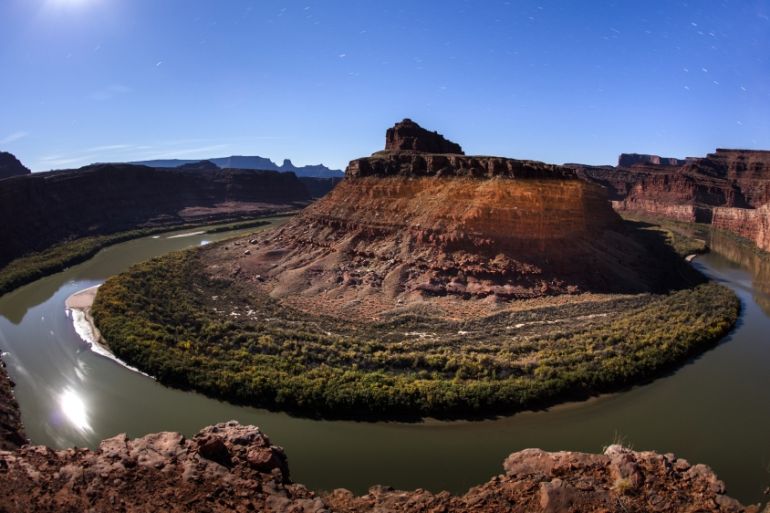Trump to review protections on vast nature preserves
Review could upend protections and restrictions on millions of acres of land designated as ‘national monuments’.

After moving to roll back climate change protections, US President Donald Trump is turning his sights on America’s vast nature preserves, with a view to possibly lifting federal protections brought in over the past two decades.
Trump is expected to sign an executive order on Wednesday reviewing the designation of tens of millions of acres of land as “national monuments” under a 1906 law known as the Antiquities Act, which was brought in by president Theodore Roosevelt to conserve America’s natural heritage.
Keep reading
list of 4 itemsRainfall set to help crews battling wildfire near Canada’s Fort McMurray
The Alabama town living and dying in the shadow of chemical plants
How India is racing against time to save the endangered red panda
The review could upend protections and restrictions on how the lands are used.
“National monument” land has come to be synonomous with a bar to drilling for fossil fuels on public land, or other commercial activities.
OPINION: The Earth versus capitalism
The aim of Trump’s review is to “give states and local communities a meaningful voice in the process”, said Ryan Zinke, interior secretary, whose department oversees federal land use under the motto “Protecting America’s Great Outdoors and Powering Our Future”.
Zinke said the outcome of the review was not preordained. His department is to provide an interim report in 45 days, then a fuller one in 120 days.
But the review could set the scene for fierce legal challenges.
While Republicans in Utah and other states are keen to lift protections they see as too expansive and undermining economic opportunities, environmental groups and Native Americans are deeply opposed.
National monuments
In the past, areas tagged as “national monuments” were later transformed by Congress into fully fledged National Parks – the Grand Canyon and Death Valley among them.
|
|
Since the Act came into force more than a century ago, only three presidents – all Republicans – did not use its powers: Richard Nixon, Ronald Reagan, and George H. W. Bush.
Barack Obama had millions of hectares classified under the act during his presidency, including maritime zones, especially in the Pacific.
Under Trump’s review, only “monuments” of 40,000 hectares or more will be examined.
A key area will be the Bears Ears National Monument, a 530,000-hectare zone in Utah that Obama designated as a national monument in 2016.
Another will be the Grand Staircase-Escalante National Monument, also in Utah – a spectacular tract of canyons, ridges and a river – designated by Bill Clinton in 1996.
OPINION: Solutions for tumultuous times
The Republican senator for Utah, Orrin Hatch, has railed against the national monument decisions made in Washington, saying his state should have more say over how the land is protected.
In a Washington Post opinion piece, Hatch said Obama “ignored the best interests of Utah and cast aside the will of the people – all in favour of a unilateral approach meant to satisfy the demands of far-left interest groups”.
Other presidents, too, went too far, Hatch opined, adding that Trump “stands ready to undo the harm brought about by their overreach”.
Trump will also sign an executive order on Friday to instigate a review of the locations available for offshore oil and gas exploration. It will also order a review of certain regulations governing offshore operations, reported the AP news agency.
Last month Trump had also declared the end of a “war on coal” as he signed an “energy independence” executive order to review some of Obama’s climate legacy, declaring an end to “job-killing regulations”.
In a maiden trip to the Environmental Protection Agency in March, he ordered a review of emission limits for coal-fired power plants and eased restrictions on federal leasing for coal production.
A coalition of 23 US states and local governments vowed to fight the order in court.
Public resistance
But Martin Heinrich, a Democratic Party senator for New Mexico, said that if Trump truly wants to “make America great again”, he should use the Antiquities Act to protect and conserve America’s public lands.
In New Mexico, Obama’s designation of Rio Grande del Norte National Monument and Organ Mountains-Desert Peaks National Monument have preserved important lands while boosting the economy, Heinrich said, a story that has been repeated across the country.
|
|
“If this sweeping review is an excuse to cut out the public and scale back protections, I think this president is going to find a very resistant public,” Heinrich told AP news agency.
Recent polls have shown strong support for national parks and monuments, said Christy Goldfuss, who directed the White House Council on Environmental Quality under Obama.
Kristina Waggoner, vice president of the Boulder-Escalante Chamber of Commerce in Utah, said businesses near the Grand Staircase-Escalante monument in southern Utah are booming, driven by sharp increases in tourism since the area was designated in 1996 by President Bill Clinton.
“I’m here today to support the monument and my three-year-old son,” Waggoner said in a conference call with reporters organised by a pro-Obama group. “Once our land is gone, it’s gone for ever.”
|
|